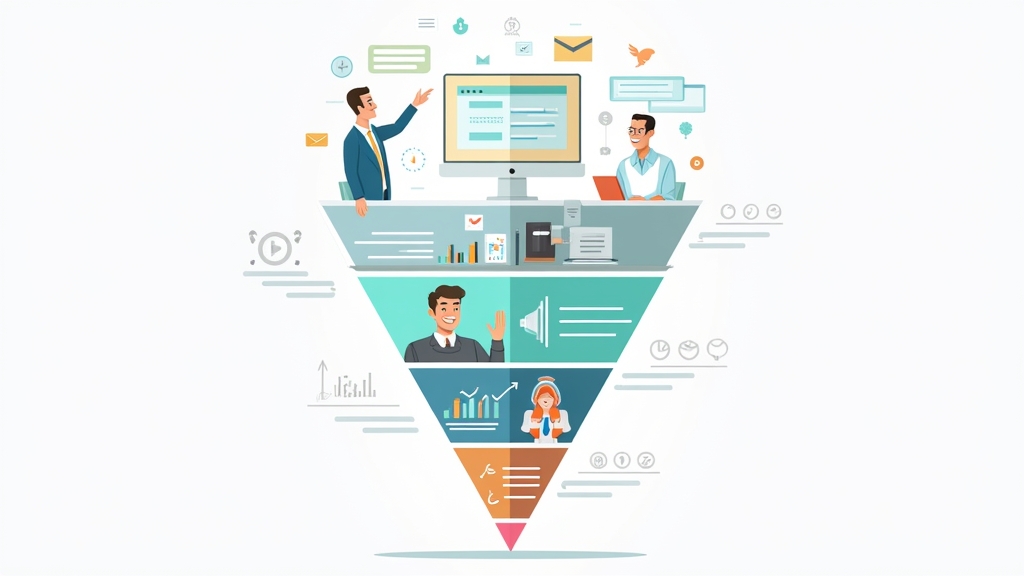Marketing Funnels Explained: Your Guide to Understanding the Customer Journey
Introduction
Marketing funnels are essential tools that help businesses understand and guide their customers through the buying process. They illustrate how potential customers move from being unaware of a product or service to making a purchase. By grasping the concept of marketing funnels, you can create effective strategies that attract and retain customers, ultimately boosting your sales. This guide will break down what marketing funnels are, their stages, types, and how to optimize them for your business success.
What is a Marketing Funnel?
A marketing funnel is a visual representation of the customer journey from awareness to purchase. It helps businesses understand how potential customers interact with their brand at different stages. The funnel starts wide at the top, where many people become aware of your product or service, and narrows down as they move closer to making a decision.
The purpose of using a funnel in marketing strategies is to identify where potential customers may drop off in their journey. By understanding these points, you can develop targeted tactics that encourage leads to continue moving through each stage until they make a purchase.
Stages of the Marketing Funnel
Awareness Stage
In the awareness stage, potential customers first learn about your product or service. This could happen through various channels like social media ads, blog posts, or word-of-mouth recommendations. At this point, they might not know much about your brand but are curious enough to seek more information.
Creating engaging content and utilizing effective advertising methods are crucial during this stage. The goal is to capture attention and spark interest so that leads move further into the funnel.
Consideration Stage
Once potential customers are aware of your offering, they enter the consideration stage. Here, they evaluate different options available in the market and compare products based on features, benefits, pricing, and reviews.
During this phase, it’s important to provide valuable information that helps leads make informed decisions. Offering comparisons or testimonials can greatly influence their evaluation process and keep them engaged with your brand.
Decision Stage
In the decision stage, consumers are ready to make their final purchasing decisions. They have weighed their options carefully and now look for reassurance before committing to buy.
To facilitate this process effectively, you should provide clear calls-to-action (CTAs), special offers like discounts or free trials, and easy access to customer support if needed. These elements can significantly increase conversion rates by addressing any last-minute hesitations from leads.
Types of Marketing Funnels
Traditional Sales Funnel
The traditional sales funnel consists of several stages: awareness, interest, desire, and action (often referred to as AIDA). Each stage represents a step in converting prospects into paying customers while focusing on nurturing relationships throughout the process.
This model emphasizes personal interactions between sales teams and prospects but may not fully capture online behaviors prevalent today.
Digital Marketing Funnel
The digital marketing funnel adapts traditional concepts for online environments by incorporating digital touchpoints such as websites and social media platforms. It often includes additional stages like engagement after initial purchases—focusing on retention through email campaigns or loyalty programs.
Understanding this type allows marketers to tailor strategies specifically for online audiences who engage differently than those in face-to-face settings.
Content Marketing Funnel
Content plays an integral role in guiding customers through all stages of any marketing funnel—especially within content marketing funnels! In this approach:
- Top-of-the-funnel content raises awareness.
- Middle-of-the-funnel content nurtures leads during consideration.
- Bottom-of-the-funnel content encourages conversions at decision time via case studies or detailed product descriptions.
By providing relevant content tailored for each stage ensures prospects receive value throughout their journey!
Importance of Understanding Your Audience
Identifying target audiences is vital when creating effective marketing funnels since different groups have unique needs! Segmenting audiences based on demographics (age/gender/location) helps tailor messages accordingly—ensuring higher engagement rates!
Customer personas also play an essential role here; these fictional characters represent ideal clients based on research data collected from existing users! Crafting personalized experiences around these personas enhances connection levels—ultimately driving better results across all phases!
Strategies for Optimizing Each Stage of the Funnel
Tips for Awareness Generation
To attract leads at the top of your funnel successfully:
- Utilize social media platforms creatively.
- Invest in search engine optimization (SEO) techniques.
- Create shareable blog posts that resonate with target audiences!
These tactics enhance visibility while establishing credibility within markets!
Enhancing Consideration Efforts
During consideration:
- Offer free resources like eBooks/webinars related directly back towards products/services offered!
- Use email drip campaigns designed specifically nurture interested parties over time!
Such actions build trust while keeping brands front-of-mind when evaluating choices available!
Closing Sales in the Decision Stage
Finally—when closing sales:
- Provide limited-time offers/discounts encouraging urgency among buyers!
- Ensure seamless checkout processes minimize friction points leading up until final transaction completion!
These techniques help convert hesitant shoppers into satisfied purchasers quickly & efficiently!
Measuring Success: Key Performance Indicators (KPIs)
Tracking key performance indicators (KPIs) throughout every phase allows businesses insight into effectiveness! Important metrics include:
- Conversion rates – percentage moving from one stage another.
- Click-through rates – measuring engagement levels across various channels used.
- Customer acquisition costs – determining expenses incurred acquiring new clientele versus revenue generated thereafter!
Regularly analyzing these figures enables continuous improvement efforts ensuring optimal results achieved consistently over time!
Conclusion
Understanding marketing funnels is crucial for guiding prospective buyers along their journey—from initial awareness all way through final purchases! By recognizing distinct stages involved along with appropriate strategies tailored toward audience needs—you position yourself better succeed within competitive landscapes today!
📢 Explore More: Continue Your Journey!
If this article helped you understand marketing funnels better check out How To Create Effective Customer Personas! It covers powerful insights helping you shape more targeted strategies tailored specifically towards engaging diverse audiences effectively.














![NEEWER 55W 18"/45cm Ring Light Kit [New Version], 5600K Dimmable ...](https://m.media-amazon.com/images/I/414QLqvZWLL._AC_.jpg)








